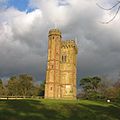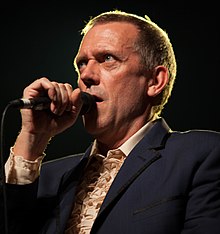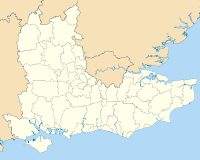The South East England Portal

South East England is one of the nine official regions of England in the United Kingdom at the first level of ITL for statistical purposes. It consists of the nine counties of Berkshire, Buckinghamshire, East Sussex, Hampshire, the Isle of Wight, Kent, Oxfordshire, Surrey and West Sussex. Cities and towns in the region include Aldershot, Ashford, Aylesbury, Basingstoke, Bracknell, Brighton and Hove, Canterbury, Chichester, Crawley, Eastbourne, Farnborough, Gosport, Guildford, Hastings, High Wycombe, Margate, Maidstone, Medway, Milton Keynes, Newport, Oxford, Portsmouth, Ramsgate, Reading, Slough, Southampton, Winchester, Woking and Worthing.
South East England is the third-largest region of England, with a land area of 19,072 square kilometres (7,364 sq mi), and is also the most populous with a total population of 9,379,833 in 2022. The region contains eight legally chartered cities: Brighton and Hove, Canterbury, Chichester, Milton Keynes, Oxford, Portsmouth, Southampton and Winchester. The region's close proximity to London has led to South East England becoming a prosperous economic hub with the largest economy of any region in the UK, after London. The region is home to Gatwick Airport, the UK's second-busiest airport, and Heathrow Airport (the UK's busiest airport) is located adjacent to the region's boundary with Greater London. The coastline along the English Channel provides numerous ferry crossings to mainland Europe.
The region is known for its countryside, which includes two national parks: the New Forest and the South Downs, as well as the North Downs, the Chiltern Hills and part of the Cotswolds. The River Thames flows through the region and its basin is known as the Thames Valley. It is also the location of a number of internationally known places of interest, such as HMS Victory in Portsmouth, Cliveden in Buckinghamshire, Thorpe Park and RHS Wisley in Surrey, Blenheim Palace in Oxfordshire, Windsor Castle in Berkshire, Leeds Castle, the White Cliffs of Dover and Canterbury Cathedral in Kent, Brighton Palace Pier, and Hammerwood Park in East Sussex, and Wakehurst Place in West Sussex. The region has many universities; the University of Oxford is the oldest in the English-speaking world, and ranked among the best in the world.
South East England is host to various sporting events, including the annual Henley Royal Regatta, Royal Ascot and The Derby, and sporting venues include Wentworth Golf Club and Brands Hatch. Some of the events of the 2012 Summer Olympics were held in the south east, including the rowing at Eton Dorney and part of the cycling road race in the Surrey Hills.
In medieval times, South East England included much of the Kingdom of Wessex, which was the precursor to the modern state of England. Winchester was the capital of England after unification of the various states, including the kingdoms of Kent, Sussex and Mercia. Winchester stopped being the administrative capital of England some time in the 13th century as its influence waned while the City of London dominated commerce. The last monarch to be crowned at Winchester was Richard II in 1377, although the last monarch to be crowned by the Bishop of Winchester was Queen Mary I in 1553. (Full article...)
Selected article
Osborne House is a former royal residence in East Cowes, Isle of Wight, United Kingdom. The house was built between 1845 and 1851 for Queen Victoria and Prince Albert as a summer home and rural retreat. Albert designed the house in the style of an Italian Renaissance palazzo. The builder was Thomas Cubitt, the London architect and builder whose company built the main facade of Buckingham Palace for the royal couple in 1847. An earlier smaller house on the Osborne site was demolished to make way for the new and far larger house, though the original entrance portico survives as the main gateway to the walled garden.
Queen Victoria died at Osborne House on 22 January 1901, aged 81. Following her death, King Edward VII, who had never liked Osborne, presented the house to the state on the day of his coronation, with the royal pavilion being retained as a private museum to Victoria. From 1903 to 1921, part of the estate around the stables was used as a junior officer training college for the Royal Navy, known as the Royal Naval College, Osborne. Another section of the house was used as a convalescent home for officers. In 1933, many of the temporary buildings at Osborne were demolished. In 1954, Queen Elizabeth II gave permission for the first floor rooms (the private apartments) in the royal pavilion to be opened to the public. In 1986, English Heritage assumed management of Osborne House. In 1989, the second floor of the house was also opened to the public.
The house is listed Grade I on the National Heritage List for England, and the landscaped park and gardens are listed Grade II* on the Register of Historic Parks and Gardens. (Full article...)
Selected pictures
Selected biography
James Hugh Calum Laurie CBE (/ˈlɒri/; born 11 June 1959) is an English actor, comedian, musician and writer. He first gained recognition for his work as one half of the English comedy double act Fry and Laurie with Stephen Fry.
Fry and Laurie acted together in a number of projects during the 1980s and 1990s, including the BBC sketch comedy series A Bit of Fry & Laurie and the P. G. Wodehouse adaptation Jeeves and Wooster. From 1986 to 1989 he appeared in three series of the period comedy Blackadder, first as a recurring guest star in the last two episodes of Blackadder II, before joining the main cast in Blackadder the Third, and going on to appear in Blackadder Goes Forth and many specials of the show except for The Black Adder and Blackadder: The Cavalier Years.
From 2004 to 2012, Laurie starred as Dr. Gregory House on the Fox medical drama series House. He received two Golden Globe Awards and many other accolades for the role. He was listed in the 2011 Guinness World Records as the most watched leading man on television and was one of the highest-paid actors in a television drama at the time, earning $409,000 (£250,000) per episode. By the end of the series, he was earning $700,000 an episode. His other television credits include starring as arms dealer Richard Onslow Roper, the main antagonist in the miniseries The Night Manager (2016), for which he won his third Golden Globe, and playing Senator Tom James in the HBO sitcom Veep (2012–2019), for which he received his 10th Emmy Award nomination.
Laurie has appeared in the films Peter's Friends (1992), Sense and Sensibility (1995), 101 Dalmatians (1996), The Borrowers (1997), The Man in the Iron Mask (1998), Stuart Little (1999), Life with Judy Garland: Me and My Shadows (2001), Flight of the Phoenix (2004), Tomorrowland (2015), Arthur Christmas (2011) in which he voiced Steven Claus, and The Personal History of David Copperfield (2020). Outside acting, he released the blues albums Let Them Talk (2011) and Didn't It Rain (2013), both to favourable reviews. Laurie wrote the novel The Gun Seller (1996). He was appointed Officer of the Order of the British Empire (OBE) in the 2007 New Year Honours and CBE in the 2018 New Year Honours, both for services to drama. (Full article...)
On This Day in South East England
6 November:
1920: Southampton's cenotaph was unveiled.
Categories
Related portals
WikiProjects
Topics
Associated Wikimedia
The following Wikimedia Foundation sister projects provide more on this subject:
-
Commons
Free media repository -
Wikibooks
Free textbooks and manuals -
Wikidata
Free knowledge base -
Wikinews
Free-content news -
Wikiquote
Collection of quotations -
Wikisource
Free-content library -
Wikiversity
Free learning tools -
Wikivoyage
Free travel guide -
Wiktionary
Dictionary and thesaurus
































































































































